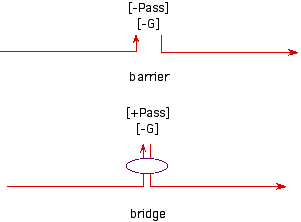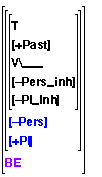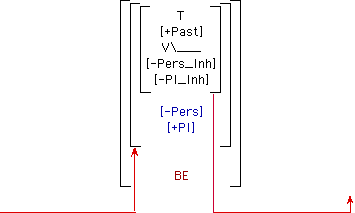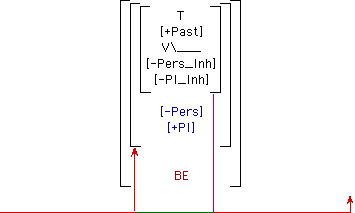![]() A barrier refers
to a barrier against government. A phrasal node can be a barrier
to the government of some object by the head of the phrase. The
first barrier that we came across was in government. X governs
YP and Y if there is no interneving node such that it governs
YP and Y. At first it was a little less than crystal clear what
a barrier was . Chomsky sometimes uses the following notation
to indicate barrier:
A barrier refers
to a barrier against government. A phrasal node can be a barrier
to the government of some object by the head of the phrase. The
first barrier that we came across was in government. X governs
YP and Y if there is no interneving node such that it governs
YP and Y. At first it was a little less than crystal clear what
a barrier was . Chomsky sometimes uses the following notation
to indicate barrier:

The above notion is based on Chomsky where a barrier indicates a broken link in some sense. We will take a somewhat different notion of a barrier. We will assume as an axiom that all categories are natural barriers in that they are not linked. If X governs Y, then a link is developed between X and Y, thus bridging over the natural barrier. If a link can't be built, then X is considered to be [-G], the feature which means the category is not a governor, and a link cannot be built. This common in affixes which, are not spelled out phonetically. For example, [-Pass] is marked [-G], which means that it does not govern. [+G] blocks the building of a bridge from one link to another.
A problem came up in the interrogative, where it is [+Strong], which means that it must govern the closest positive operator (other than tense which is incorporated into M). However, the operator must govern the next positive operator or the main verb itself. In the above notation, the double slash would block government of the operator or main verb if it occurred in the link of which the operator is the head, or it would block the government of the operator which determines the dummy verb to be selected. Either way, we get an unwanted barrier.
The older solution was to assume that the barrier does occur along the link as above, but between the links at the crucial node:

This way [+Interr] may still govern the operator in question, and the operator may govern the next positive operator, but the barrier between the links means that the features of Tense (or some other operator) cannot be copied from one link to the next link as the thick bar indicates above.
We now assume that the barrier is always there, that it isn't inserted. This costs us very little since it is very general. Revising the above approach, we will remove the dark line in the upper structure. The barrier is automatic. To exchange information, a bridge must be built from one link to the other:

In the case of the operators of the noun, no bridge can be built. Hence a barrier exists. The information, however, is passed by a different built in mechism. Information is automatically transferred between identical features that are linked. If they do not agree, a crash results. The information then is passed through this common feature, to which both features are directly connected.
As a strategy a barrier is:
As a strategy a bridge is:
Where a connection is not to be made, the heads is renderred as [-G].
Think of a barrier as a link that fail to be linked to an adjacent link. It is through linked links that information is passed. A break in the chain is called a barrier here.
We need to look closely at the feature structure of a node. Outside of the notational use of a square bracket to represent a single feature (which is sometimes omitted to save space), a basic (underived) lexeme is enclosed in brackets. Let us look at the structure for [T +Past] in more detail:

Next, the features of the subject are copied to T to satisfy the inherent features which need a specific value. Let us Suppose the subject is third person plural. This set of features is result of a process and is enclosd in a new outer set of brackets. Note that in the past we have been using blue to denote these features; we will continue to do so here for clarity:

When this form cannot find a main verb as a host (because of a barrier), a dummy verb is inserted. Let us suppose that it is do. This time will use another colour to mark the next level:

Nest, where does the link fit into the above structure. Since T,[+Past] governs V, the link should descend directly from the innermost set of brackets (it directly contains V). The link transferring the information of person and number to T should ascemd dorectly to the second set of brackets, which directly contains person and plural. (We have to use a different graphics program to illustrate this since the one above cannot display straight lines):

Information can be assigned from the innermost brackets to the link leading away from it. Information from the tail of the left link can be transferred to the second bracket, but not to the innermost bracket. For information to be transferred from one link to another, the two links must be linked forming a chain. If they are not loinked, no chain is formed, and the information cannot be passed through the chain. The failure to link the two links is tantamount to what we have been calling a barrier.
The problem now facing us is how to represent the barrier. We could use the above diagram, where the two links are not shown as linked. If we were to adopt this, then how could we represent two linked links? One way is to build a bridge from the left link to the right link. The concept of a bridge is more than 20 years old, but not discussed much today. Let us reintroduce it as we will use in L405/801. A bridge links two links forming a chain. The default rule would be to bridge all gaps (barriers), except under the conditions where we would insert a barrier. We will represent the bridge as a straight link from one link to the next:

Here, we will colour the bridge to make it more distinctive, but since colour does not show on laser writers, colour is optional.
![]()
![]() To return to course outline
Click here.
To return to course outline
Click here.
![]()